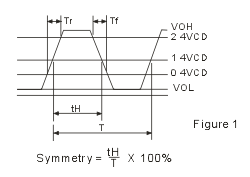|
 Nominal frequency: Nominal frequency:
The enter or nominal output frequency of a crystal oscillator.
 Package: Package:
Crystal oscillators are packaged in various styles from lead through holes to surface-mount types. Various sizes and functions are suitable for different applications.
 Frequency tolerance: Frequency tolerance:
The deviation from the nominal frequency in terms of parts per millions (ppm) at room temperature.(25°C±5°C)
 Frequency range: Frequency range:
The frequency band that the oscillator type or model can be offered.
 Frequency stability: Frequency stability:
The maximum allowable frequency deviation compared to the measured frequency at 25°C over the temperature window, i. e., 0°C to +70°C typical stability is 0.01% (100 ppm).
 Operable temperature: Operable temperature:
Temperature rang within which output frequency and other electrical, environmental characteristics meet the specifications.
 Aging: Aging:
The relative frequency change over a certain period of time. This rate of change of frequency is normally exponential in character. Typically, aging is ±5ppm over 1 year maximum.
 Storage Temperature: Storage Temperature:
The temperature range where the unit is safely stored without damaging or changing the performance of the unit.
 Frequency vs. Power Supply Variation: Frequency vs. Power Supply Variation:
Maximum frequency change allowed when the power supply voltage is changed within its specified limits (typical 10% in Vcc or ±5% change).
 Supply Voltage (Vdd max): Supply Voltage (Vdd max):
The maximum voltage which can safely be applied to the Vcc terminal with respect to found. Maximum supply voltage for TTL and CMOS is 5.5V
 Input Voltage (VIN): Input Voltage (VIN):
The maximum voltage that can be safely applied to any input terminal of the oscillator.
 Output Voltage (VOH): Output Voltage (VOH):
The minimum voltage at an output of the oscillator under proper loading.
 Input HIGH Voltage (VIH): Input HIGH Voltage (VIH):
The maximum voltage to guarantee the threshold trigger at the input of the oscillator.
 Input HIGH Voltage (VIL): Input HIGH Voltage (VIL):
The minimum voltage to guarantee the threshold trigger at the input of the oscillator.
 Supply Current (Icc): Supply Current (Icc):
The current flow into Vcc terminal with respect to ground. Typical supply current is measured without load.
 Symmetry or Duty Cycle: Symmetry or Duty Cycle:
The symmetry of the output waveform at the specified level (at 1.4V for TTL, at 1/2 Vcc for CMOS, or 1/2 waveform peak level for ECL)

 Fan Out: Fan Out:
The measure of driving ability of an oscillator, expressed as the number of inputs that can be driven by a single output. It can be represented by an equivalent load capacitance (CL) or a TTL load circuit consisting of diodes, load resistor, and a capacitor.
 Rise Time (Tr): Rise Time (Tr):
Waveform rise time from Low to High transition, measured at the specified level
10% to 90% for CMOS,
20% to 80% for ECL
0.4V to 2.4V for TTL.
 Fall Time (Tf): Fall Time (Tf):
The waveform fall time from High to Low transition, measured at the specified level
90% to 10% for CMOS,
80% to 20% for ECL
2.4V to 0.4V for TTL.
 Jitter: Jitter:
The modulation in phase or frequency of oscillator output.
CMOS/TTL Compatible: The oscillator is designed with CMOS logic with driving capability of TTL and CMOS loads while maintaining minimum logic HIGH of the CMOS.
 Tri-state Enable: Tri-state Enable:
When the input is left "open" or tied to logic "1", the normal oscillation occurs. When the input is grounded (tied to logic "0"), the output is in "high impedance" state. The input has an internal pull-up resistor thus allowing the input to be left open.
 Output Logic: Output Logic:
The non-linear distortion due to unwanted harmonic spectrum component related with target signal frequency. Each harmonic component is the ratio of electric power against desired signal output electric power and is expressed in terms of dBc, i.e.-20dBc. Harmonic distortion specification is important especially in sine output when a clean and less distorted signal is required.
 Phase Noise: Phase Noise:
The measure of the short-term frequency fluctuations of the oscillator. It is usually specified as the single side band (SSB) power density in a 1 Hz bandwidth at a specified offset frequency from the carrier. It is measured in dBc/Hz.
 Stand By: Stand By:
A function that temporary turns off the oscillator and other devices to save power. Logic "0" will enable stand by mode. The disable current at stand by mode varies from a few micro-amperes to tens of micro-amperes (5 A typical). Because oscillation is halted, there is a maximum of 10 ms (same amount of start-up time) before output stabilizes.
| 
